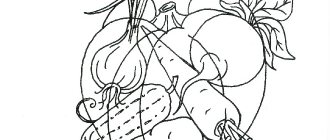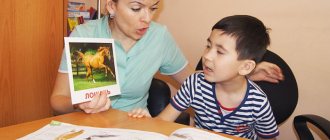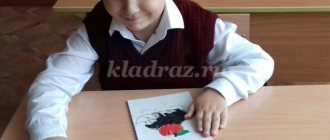Memory is the main skill in our life. Without memory we will not be able to speak or even think. Just think and imagine that you don’t remember anything, that you can’t say anything. We need memory for development, for moving forward, for learning, for acquiring new knowledge and skills.
It is necessary to develop not only memory, but also attention, thinking and logic.
Many children are given a good memory from birth; learning is easy for these children from childhood, they do not need to put a lot of effort into the memorization process, they remember easily without putting in additional effort.
Others, on the contrary, have to work hard, study, study extra in order to better master the material and achieve something in life.
Memory must be developed from birth to old age. You can develop memory at any age; it is never too late to start developing it; the most important thing is that you have the desire and desire to develop memory.
Development of memory and attention
- Concentrate on one thing. If you are working with a child, do not distract him with little things and try to focus his attention on what you are doing. If the child is distracted, perhaps he is not interested in this activity, your task is to interest your child.
- Proper nutrition for the brain is very important. Do not feed your child fast foods and snacks on the run; this is harmful to both the brain and his growing body. A proper diet should include the following foods: vegetables, fruits, dried fruits, nuts, dairy products, honey, cereals and herbs.
- Don't overload your child's brain. If your child begins to become distracted, perhaps tired or uninterested, give your child some rest and recuperation. In the evening, review the material covered with your child so that he understands it better. A tired brain does not perceive new information well.
- Never overload your child's brain with unnecessary, unnecessary information. Load it only with useful and truly important information.
- There must be walks in the fresh air - this is also very important for the proper functioning of the child’s brain. The brain must receive oxygen. It’s good if you take active walks with your child in the fresh air. You can engage in various sports with your child or simply relax actively and play outdoor games.
How to train visual memory of preschool children?
After the examination, it will be easy for parents to assess the level of visual perception in their preschooler and select educational games or exercises for home activities. The main thing is that they must remember the features of carrying out exercises for the development of a child:
- Tasks must correspond to the level of development, their complexity increases gradually.
- The lack of arbitrariness of the child’s actions is taken into account, so during training it is necessary to interest him in game techniques, competitive moments, and prizes.
- The tasks must be understandable to children; for this purpose, instructions are given in simple, accessible language.
- To get the best results when training visual memory, it is necessary to use auditory sensations and motor skills.
Exercises to develop memory and attention
First exercise “Name what you see”
Talk a lot and constantly with your child; the more he listens to you, the more he will concentrate on what you are telling him.
At home, you can show your child different objects, unusual objects, for example, paintings. Tell us what is drawn in the picture, what colors the artist used, what frame the picture has, the child is interested in all this. On the street in the summer, you can tell what flowers are blooming, describe these flowers in more detail, what birds live in your city, and show them to the child, look at them beautiful houses and so on.
The child, together with you, gets to know the world around him; he is interested in listening and touching everything.
Then you can take one thing, for example, a green leaf from a tree and look at it carefully. What leaf, from what tree, what color is the leaf, what size, and so on.
Second Do and Tell Exercise
It is very important to teach a child to concentrate on even the simplest task. Draw with your child. Give your child a task to draw, for example, a house.
Explain to the child out loud what he must do, correct him, pronounce every movement of the child. Communicate more with your child and comment out loud on his actions.
Teach your child to perform all actions sequentially. Gradually, the child will learn to do everything consistently, independently.
Third exercise “Find the object”
The game, find the object, is well suited for developing attention and memory. Come up with some object that is in the room so that the child knows this object well.
For example, it could be a typewriter.
Describe the machine in as much detail as possible, what it is, what size and color, what can be done with this machine, what parts this machine has, and so on.
If the child quickly guesses what is being said, take another object and repeat the exercise.
Try to play the other way around, let the child come up with some object and describe it in detail, and you try to guess what kind of object it is.
Fourth exercise: “Let’s look at each other”
The exercise, let's see, looks at each other well, develops your child's attention and memory, it is very simple, interesting and fun. Your child will enjoy playing this game.
Give your child the opportunity to look at you carefully for a few seconds. Then he turns away and tells you everything he remembers about you. For example, hair color, description of your face, what you are wearing, what color, and so on. If the child could not tell much, do not scold him, play this game again. Studying you, the second time the child will be more attentive than the first time.
You can even play this game in reverse, look at your child, turn away and describe what you remember. Your child will draw conclusions, he will compare your detailed description with his description and understand what he missed in the story. You can talk through these conclusions while delving into the details together.
Fifth exercise “Disturb me”
Interesting exercise, disturb me. Here you can play together - dad, mom and child.
The role of the father is to ask different questions to the child, for example, what color is the cube, does the car have wheels, where is the ball, what is your name, and so on. The child must answer questions quickly.
The mother's role is to distract the child when he answers questions. If your child was able to answer the questions without getting distracted, reward him. Next time he will try even better.
This game can be played by two people, for example, a child recites a poem or retells a fairy tale, and you distract him.
Exercise 6: “Be Attentive”
Recently, children's books often offer memory development exercises. For example:
A picture is drawn, the child looks and remembers what is depicted on it.
After two or three minutes the book closes and the child must tell what he remembers. This is a simple task, but it trains your memory well.
If the child remembers little or says it incorrectly, play together. Look at the picture, close it and try to tell in great detail what you remember. The child will listen carefully to your story and, remembering the next picture, he will try to remember as much as possible. Children always love it when adults play interesting and educational games with them.
Seventh exercise “Try to remember”
You can develop observation, attention and visual memory in different ways. Let's consider one of them.
For example:
Let's take five different objects for children. It could be a pencil, a pen, a colored eraser, a ball, or a jump rope.
We let the children look at all these items, then put them in a dark bag. The child is given two minutes to memorize. The guys must take turns telling what they remember.
If you and your child are playing together, memorize the items one by one and tell each other.
Each next lesson, try to reduce the memorization time.
Eighth exercise “Remember and tell from memory”
Recently, very often children's books offer exercises for memory development.
For example: The fairy tale “Turnip”.
A picture is drawn, the child looks and remembers what is depicted on it.
After two or three minutes the book closes and the child must tell what he remembers. This is a simple task, but it trains your memory well.
Ninth exercise “Look and remember”
Look carefully at the following picture, remember what it shows. Ten seconds are given to memorize. Close the picture and draw the same one from memory. If the child is small, then let him tell from memory what he remembers.
Tenth exercise “Remember different things”
Look carefully at the following pictures, different objects are drawn here. Look and remember what is drawn. Cover the picture and tell me from memory what you remember. You have one minute to memorize.
If the child is small, you can memorize one or two lines at a time, then each time let the child memorize more pictures.
You can develop your child's memory and attention with the help of educational games for children.
Memorization Features
Vision becomes the first way of contact with the outside world for young children. With its help, they begin to remember everything that happens around them and perceive other people. After this, other types of memory are used.
An adult has already formed intelligence and certain abilities. Many people might say that their visual memory is not that good. In such cases, you can use special exercises and try to correct the situation.
Anyone can test themselves if they wish. A simple exercise will show how developed your visual memory is. Given its results, it will be possible to decide whether it is necessary to train memorization using the eyes at all. The essence of the test is as follows:
- The assistant must select 10 different images. Any pictures that have significant differences between them (for example, different animals) will do. It is advisable to print them out and cut them into small cards.
- The test taker’s task is to look at all the pictures as clearly as possible. He is given only 20 seconds to do this. When the time is up, you will need to name everything that was seen on the cards.
The assistant must listen carefully to the test taker and draw conclusions about the quality of his memory. Most often, this test is used for children, because for many adults is not so difficult. Nevertheless, it will definitely be possible to identify bad memory with its help. If you want to complicate the task, then you can use more specific cards or create additional conventions.
Visual memory improves every time a person actively uses it. Its formation begins in childhood and continues throughout life. Therefore, it is especially developed among those people whose profession often requires visually remembering various things and documents.
People with well-developed visual memory are distinguished by increased attentiveness and the ability to concentrate easily.
Educational games for children
Game 1 "Pathfinder"
The Pathfinder game develops memory.
The main essence of the game is to remember the tracks of animals and repeat them.
In this game, animal tracks appear on the screen for a few seconds, look carefully and remember in what order the tracks appear. Then you need to show which trace appeared first, and which second. Read the question correctly. If you answered correctly, then you score points and continue to play.
Play now
Game 2 "Diamonds"
The game "Diamonds" develops memory.
The main essence of the game is to remember the order of the figures that light up on the screen and repeat it.
The figures light up on the screen one by one, remember the order in which these figures light up and repeat it. You can do this using the mouse or the cursor on the keyboard. If you answered correctly, then you continue to score points and play further.
Play now
Game 3 "Speed Comparison"
The game "Speed Comparison" develops memory and attention.
The main point of the game is to remember the previous item and compare it with the current one on the screen.
An object is displayed on the screen, you remember it and compare it with the next object, if the object is the same, then answer “yes”, if different objects answer “no”. You can answer using the “yes” and “no” buttons located at the bottom. If you answer incorrectly three times, the game ends. If you answer correctly, you continue to play and score points.
Play now
Game 4 “Complicated high-speed movement”
The game “Complicated high-speed movement” develops memory and attention.
The main point of the game is to remember the previous item and compare it with the current one on the screen.
An object is displayed on the screen, you remember it and compare it with the next object, if the object is the same, then answer “yes”, if the objects are different, answer “no”, if the objects are similar, answer “partially coincides”. This game is designed to increase speed. If you answer incorrectly three times, the game ends. If you answer correctly, you continue to play and gain points.
Play now
Game 5 “Memorize and call”
The game “Memorize and Call” develops memory and attention.
The main point of the game is to remember the numbers in the table and call them in ascending order.
In this game, a table with numbers is given, first the numbers are shown on the screen, you need to remember them, then the numbers are covered. Remember where the smallest number is located and click on this cell, then click on the cell where the next number goes in ascending order. If you answered correctly, then you score points and continue playing.
Play now
Game 6 “Numerical Reach”
The game "Number Span" develops memory and attention.
The main point of the game is to remember the previous number and compare it with the current one on the screen.
In this game, numbers appear on the screen for a few seconds; you need to remember them, then they disappear, and an empty window remains, you need to remember and write in the empty window the numbers that you remembered. If you remember the numbers correctly, you move on and score points, but If you get the numbers wrong three times, the game ends.
Play now
Game 7 “Memory Matrix”
The game "Memory Matrices" develops memory and attention.
The main essence of the game is to reproduce the position of the shaded figures.
In each round, a playing field consisting of cells is shown, a certain number of cells are filled in, the rest is left free. You need to remember the location of these cells and repeat their position after they have disappeared on the screen. If you mark the cells correctly, then you score points and move on to play.
Play now
Game 8 "BrainFood"
The BrainFood game develops memory and attention.
The main essence of the game is that in each round a set of elements is shown; you must choose from the set the one that has not yet been selected in previous rounds.
In this game, drinks and food are offered on the screen. You have to choose one thing. In each subsequent round, you must choose a different dish that differs from the previously selected dishes. You need to remember and always choose different dishes and drinks. If you answer correctly, then you gain points and continue to play.
Play now
Game 9 “Super Memory”
The game “Super Memory” develops memory and attention.
The main essence of the game is that every round a new object appears on the screen; you need to indicate it by clicking on it.
In this game, a round starts and a picture appears on the screen, in the next round another picture appears and the old picture is saved. You only need to click on a new picture, you don’t need to click on old pictures again. If you answer correctly, then you gain points and continue to play.
Play now
Game 10 "Spatial speed comparison"
The game “Spatial Speed Comparison” develops memory and attention.
The main essence of the game is a series of drawings on the screen; you need to compare them with the previous drawing and answer whether it is repeated or not.
In this game, a figure appears on the screen, you have to remember it, then it disappears and another figure appears. Compare the figure on the screen with the previous figure. You can answer using the “yes” and “no” buttons below. If you answer correctly, you score points and play further.
Play now
Developing associative memory
The development of associative memory in elementary school students is a very effective method. There is a whole science for training the formation of associations - mnemonics. Exercises to develop associations include diagrams, tables, pairs of words that are not related in meaning. Regarding the latter, name a couple of words that have different meanings and give the child the task of coming up with a story using these words. And diagrams and tables with pictures will teach children to write stories; perform some manipulations in a certain sequence, for example, getting dressed. Mnemonic diagrams help increase vocabulary and quickly memorize text. They say that a poem is best remembered if you “see” it.
Courses for the development of intelligence
In addition to games, we have interesting courses that will perfectly pump up your brain and improve your intelligence, memory, thinking, and concentration:
Development of memory and attention in a child 5-10 years old
The purpose of the course: to develop the child’s memory and attention so that it is easier for him to study at school, so that he can remember better.
After completing the course, the child will be able to:
- 2-5 times better to remember texts, faces, numbers, words
- Learn to remember for a longer period of time
- The speed of recalling the necessary information will increase
Sign up for a courseRead more
Secrets of brain fitness, training memory, attention, thinking, counting
If you want to speed up your brain, improve its functioning, improve your memory, attention, concentration, develop more creativity, perform exciting exercises, train in a playful way and solve interesting problems, then sign up! 30 days of powerful brain fitness are guaranteed to you:)
Sign up for a courseRead more
Super memory in 30 days
As soon as you sign up for this course, you will begin a powerful 30-day training in the development of super-memory and brain pumping.
Within 30 days after subscribing, you will receive interesting exercises and educational games in your email that you can apply in your life.
We will learn to remember everything that may be needed in work or personal life: learn to remember texts, sequences of words, numbers, images, events that happened during the day, week, month, and even road maps.
Sign up for a courseRead more
How to improve memory and develop attention
Free practical lesson from advance.
Sign up for freeRead more
Money and the Millionaire Mindset
Why are there problems with money? In this course we will answer this question in detail, look deep into the problem, and consider our relationship with money from psychological, economic and emotional points of view. From the course you will learn what you need to do to solve all your financial problems, start saving money and invest it in the future.
Sign up for a courseRead more
Speed reading in 30 days
Would you like to quickly read books, articles, newsletters, etc. that interest you? If your answer is “yes,” then our course will help you develop speed reading and synchronize both hemispheres of the brain.
With synchronized, joint work of both hemispheres, the brain begins to work many times faster, which opens up much more possibilities. Attention , concentration , speed of perception are enhanced many times over! Using the speed reading techniques from our course, you can kill two birds with one stone:
- Learn to read very quickly
- Improve attention and concentration, as they are extremely important when reading quickly
- Read a book a day and finish your work faster
Sign up for a courseFree lesson
We speed up mental arithmetic, NOT mental arithmetic
Secret and popular techniques and life hacks, suitable even for a child. From the course you will not only learn dozens of techniques for simplified and quick multiplication, addition, multiplication, division, and calculating percentages, but you will also practice them in special tasks and educational games! Mental arithmetic also requires a lot of attention and concentration, which are actively trained when solving interesting problems.
Sign up for a courseRead more
Types of memory
There are several types of memory, depending on the storage period of information, the object of memorization, the form of storing information in memory, etc.
By shelf life
- Instant memory is image memory. Perception of information by the senses, without any processing.
- Short-term. Quickly remember information for a short period of time. This could be a phone number, date, password, address.
- Long-term. Deep memorization of important details that can influence later life. It is formed by separating fragments from short-term memory and moving them by force of will into long-term memory.
By object of memorization
- Visual: retention and reproduction, if necessary, of visual symbols (memory of faces, etc.).
- Auditory: storing sound images and impressions.
- Tactile: retention of sensations obtained when touching something.
- Emotional: preserving the sensations obtained during a shock, a surge of feelings.
- Gustatory: remembering taste sensations.
- Olfactory: perception of smells.
- Motor, or motor: remembering, storing and reproducing various movements.
According to the form of storing information in memory
- Figurative: the brain has the ability to collect scraps of sensory impressions and create images based on them that provide a reference to the necessary information.
- Verbal-logical: remembering and reproducing thoughts in the process of thinking, thinking, reading books, etc.
On the participation of the will in memory processes
- Voluntary: with the application of effort and the formation of a specific goal. For example, when preparing for an exam.
- Involuntary: when information is stored in the head automatically.
On the participation of thinking in memory processes
- Mechanical: thorough memorization of information without one’s own associations and without resorting to personal experience.
- Logical: the main thing is the essence of what you need to remember, without cramming.
- Associative: Using personal experience to connect with new experiences.
Briefly, the information given above can be presented in the form of a table.
| Criterion | Types of memory |
| By information storage period |
|
| By object of memorization |
|
| According to the form of storing information in memory |
|
| On the participation of the will in memory processes |
|
| On the participation of thinking in memory processes |
|








